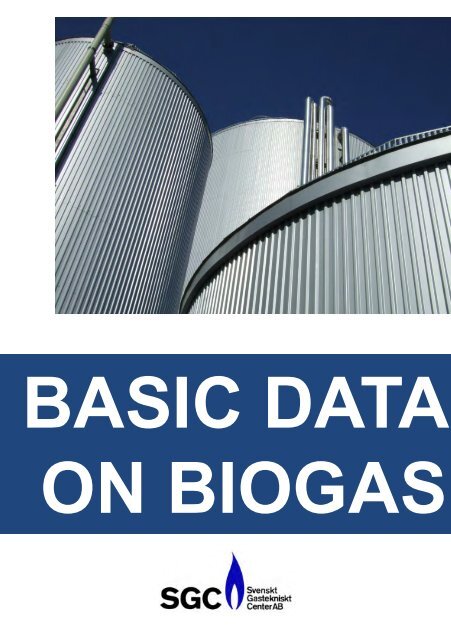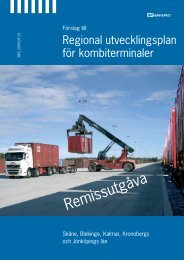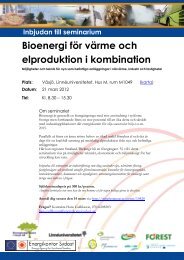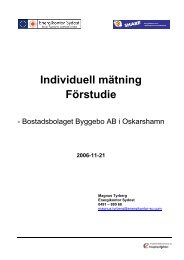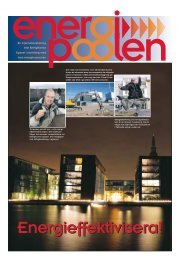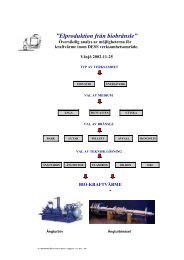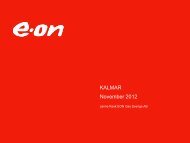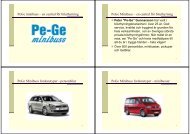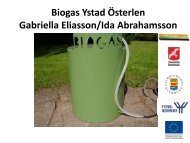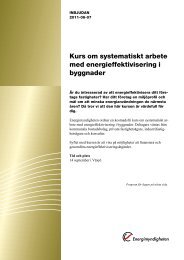BASIC DATA ON BIOGAS - Energikontor Sydost
BASIC DATA ON BIOGAS - Energikontor Sydost
BASIC DATA ON BIOGAS - Energikontor Sydost
- No tags were found...
You also want an ePaper? Increase the reach of your titles
YUMPU automatically turns print PDFs into web optimized ePapers that Google loves.
<strong>BASIC</strong> <strong>DATA</strong><strong>ON</strong> <strong>BIOGAS</strong>
ISBN: 978-91-85207-10-72 nd editionYear of publication: 2012Svenskt Gastekniskt Center ABScheelegatan 3SE - 212 28 MALMÖSWEDENwww.sgc.se
Swedish Gas Centre: Basic Data on BiogasPrefaceRenewable gases such as biogas and biomethane are considered as keyenergy carrier when the society is replacing fossil fuels with renewablealternatives. In Sweden, almost 80% of the fossil fuels are used in thetransport sector. Therefore, the focus in Sweden has been to use theproduced biogas in this sector as vehicle gas.“Basic Data on Biogas” contains an overview of production, utilisation,climate effects etc. of biogas from a Swedish perspective. The purpose is togive an easy overview of the current situation in Sweden for politicians,decision makers and interested public. Swedish Gas Center Ltd (SGC) hasbeen responsible for the writing with financial support from Avfall Sverige,Energigas Sverige, E.<strong>ON</strong>. Gas Sverige AB, Greenlane Biogas AB, GöteborgEnergi AB, LRF, Lunds Energikoncernen AB, Läckeby Water AB, MalmbergWater AB, NSR AB, Processum Biorefinery Initiative AB, Stockholm Gas AB,Svensk Biogas i Linköping AB, Svenskt Vatten and Swedish Energy Agency.The translation has also been supported by EU through Biomethane Regionsand Intelligent Energy Europe.The assignment of SGC is to co-ordinate the Swedish industrial interest inR&D focused on gas fuel technology. This is performed on a "non profit"-base. The Swedish government represented by the Swedish Energy Agencyparticipates in financing the R&D-program. SGC was established in 1990. Formore information, please visit, www.sgc.se.This publication is an updated version of “Basic Data on Biogas”, that waspublished for the first time in 2007.
Production of biogas1.4 TWh of biogas is produced annually in Sweden at approximately 230facilities. The 135 wastewater treatment plants that produce biogascontribute with around half of the production. In order to reduce the sludgevolume, biogas has been produced at wastewater treatment plants fordecades. New biogas plants are mainly co-digestion plants and farm plants.The landfilling of organic waste has been banned since 2005, thus thebiogas produced in landfills is decreasing.Biogas plantsSwedish Gas Centre: Basic Data on BiogasNumberEnergy in biogas[GWh/year]Wastewater treatment plants 135 614Co-digeston plants 18 344Farm plants 14 16Industrial wastewater 5 114Landfills 57 298Sum 229 1 387Source: Swedish Energy Agency, Produktion och användning av biogasår 2010; ES2011:071
SubstrateSwedish Gas Centre: Basic Data on BiogasPotential biogas productionThere is a large potential to increase the Swedish biogas production asbiogas can be produced from various types of substrates that are currentlytreated as residues or waste. Agricultural residues represent the greatestpotential resource. The theoretical potential biogas production in Swedenhas been estimated to be more than 15 TWh/year, which is around tentimes more than the current production.Potential biogasproduction withlimitations * [TWh]Total biogaspotential[TWh]Food wastes 0.76 1.35Wastes from parks and gardens 0 0.40Industrial waste and residues(including food industry)1.06 1.96Sludge from wastewater treatmentplants0.70 0.73Agricultural residues and manure ** 8.10 10.78Totalt 10.62 15.22*Taking into account limitations in todays technical and economical situation.**5.8 TWh of this potential origins from straw which requires pretreatment before digestion.Source: Den svenska biogaspotentialen från inhemska restprodukter, 2008.Biogas can also be produced from crops. This potential is difficult to estimateand depends entirely on which assumptions are made regarding land use, cropand yield. If 10 % of the agricultural land in Sweden is used, approximately 7TWh of biogas could be produced annually.(Source: Biogaspotential och framtida anläggningar i Sverige, 1998)2
The biogas processSwedish Gas Centre: Basic Data on BiogasBiogas, which is mainly composed of methane and carbon dioxide, isproduced during the decomposition of organic matter in anaerobicconditions. The organic matter is decomposed in a number of steps in acollaboration between several different types of microorganisms. Theefficiency of the biogas production depends on how suitable the conditionsare for the microorganisms. To initiate a biogas process, sludge containingthe bacteria for starting the process is inoculated from an existing biogasplant.The biogas process divided into a number of stages that take place duringdigestion. (Illustration: Energigas Sverige)3
Swedish Gas Centre: Basic Data on BiogasParameters for the biogas processLoading rateAmount of substrate added to the digester. Expressede.g. as kg VS per m 3 digester and day.Biogas production Amount of produced biogas expressed e.g. Nm 3 per tonTS.C/N-quota Relation between carbon and nitrogen content in thesubstrate.Pretreatment Prior to digestion, many substrates needs to bepretreated. This pretreatment can be pasteurisation,thickening or disintegration.Volatile Solids –VSMesophilicDigestionMethaneconcentrationMethane yieldThermophilicDigestionTotal Solids – TSWeight of organic matter in the substrate. Normallyexpressed as percentage of TS.Digestion at 25-40°C. Usually around 35-37°C.Amount of methane in the biogas. Normally expressedas percentage by volume.Amount of produced methane expressed e.g. Nm 3 perton TS.Digestion at 50-60°C. Usually around 50-55°C .The weight of the substrate after drying. Normallyexpressed as percentage of wet weight. Also called drymatter (DM)Dry Digestion Digestion of substrate with TS around 15-35 %.Hydraulicretention timeThe average time that the substrate is inside thedigester.Degradation of VS Describes how much of the substrate that is degradedin the digester. Usually expressed as percentage of VS.Wet digestion Digestion of substrate with TS around 2-15 %.Wet weightThe weight of the substrate including water.4
Swedish Gas Centre: Basic Data on BiogasBiogas production for different substratesThe biogas production varies between different substrates depending onthe composition of the substrate. The biogas production figures in the tablebelow are determined in laboratory scale and therefore higher thanexpected during continuous operations in full scale.SubstrateMethaneTS Biogas productionconcentration[m[%] [m 3 /ton TS]/ton[%]wet weight ]Sludge from wastewatertreatment plants5 300 15 65Fish waste 42 1 279 537 71Straw 78 265 207 70Sorted food waste 33 618 204 63Liquid cattle manure 9 244 22 65Potato haulm 15 453 68 56Slaughter house waste 16 575 92 63Liquid pig slurry 8 325 26 65Sources: Substrathandbok för biogasproduktion, SGC, 2009Den svenska biogaspotentialen från inhemska restprodukter, 2008Ökad biogasproduktion vid Henriksdals reningsverk, 20095
Biogas production from cropsBiogas production in Sweden could be greatly increased by using crops.Examples are given in the table below.SubstrateHarvest 1) TS Methane yield[ton/haand year]Swedish Gas Centre: Basic Data on Biogas[% of wetweight][Nm 3methane/ tonwet weight]Substrateneed[ton/GWh]Landrequirement[ha/GWh]Jerusalemartichoke 2) 60 22 48 1500 25Maize 43 30 95 1070 25Potato 26 25 100 1020 39Sugar beet 3) 50 24 94 1090 22Grass 22 35 95 1100 50Wheat grain 5.2 86 370 300 581)Harvest quantities are valid in the area of Mälardalen.2)Data is valid for harvest of stem.3)Harvest quantities are valid in the area of Skåne.Source: http://www.bioenergiportalen.se, 2011-02-156
Upgrading of biogasSwedish Gas Centre: Basic Data on BiogasTo increase the energy density of the biogas, it is possible to upgrade it withdifferent technologies. In practice, this is performed by removing themajority of the carbon dioxide. Examples of techniques are given in thetable below.Technique Function RegenerationPressure SwingAdsorption (PSA)Water scrubberChemicalabsorptionMembraneCryogenicseparationAdsorption of carbon dioxideon e.g. activated carbon.Absorption of carbon dioxidein water.Chemical reaction betweencarbon dioxide and amine –based solvents.Separation through amembrane that is permeablefor carbon dioxide.Cooling until condensation orsublimation of the carbondioxideDepressurisationDepressurisation andcounter flow of air.Heating--To increase the energy density even further, it is possible to condense thebiogas by cryogenic cooling. Liquified biogas is normally abbreviated LBG.8
Energy content of biogasA typical normal cubic meter of methane has a calorific value of around 10kWh, while carbon dioxide has zero. The energy content of biogas istherefore directly related to the methane concentration. In other words,assuming a biogas composition with 60% methane, then, the energycontent would in this case be around 6.0 kWh per normal cubic meter.Vehicle fuel1 Nm 3 upgraded biogas(97 % methane)Swedish Gas Centre: Basic Data on BiogasEnergy content [kWh]9.671 Nm 3 natural gas 11.01 litre petrol 9.061 litre diesel 9.81 litre E85(vehicle fuel with 85%ethanol and 15% gasoline)6.37 (summer, 85% ethanol)6.59 (winter, 79.5% ethanol)Sources: Energinet.dk, www.energinet.dk, 2011-02-15Preem, www.preem.se, 2011-02-15This in turn implies that the energy content in 1 Nm 3 biogas corresponds toaround 1.1 litres of petrol and the energy content in 1 Nm 3 natural gascorresponds to around 1.2 litres petrol.In the figure below, the volumes of compressed (200 bar) and liquefiedbiogas with the same energy content as 1 litre petrol are shown.1 litre petrol 4.0 litres biogas200 bar1.7 litres LBG9
Swedish Gas Centre: Basic Data on BiogasMethaneMethane is the simplest alkane and consistsof one carbon atom and four hydrogen atomsand is probably the most abundant organicmolecule on earth.Property Unit ValueDensity, gas kg/m 3 0.72Relative density 0.56Density, liquide kg/m 3 423Upper calorific value kWh/Nm 3 11.0Lower calorific value kWh/Nm 3 9.97Wobbe index, upper kWh/Nm 3 14.8Wobbe index , lower kWh/Nm 3 13.3Flammable range % 4.4 – 16.5Boiling point °C -161.5Source: Encycopedie des Gaz, L’air LiquideSafetyThere exists several safety aspects that need to be considered duringproduction and handling of biogas. It is very important to be aware of therisks and to minimise these. The most common risks are:• Flammability• Poisoning (mainly H 2 S)• Suffocation• Risks caused by high pressures• Thermal injuriesAs the density of upgraded biogas is lower than air, any gas leaking will riseupward. In addition, upgraded biogas has a higher temperature of ignitionthan both petrol and diesel. This means in turn that the risk of fire orexplosion in traffic accidents is smaller for upgraded biogas than for petrolor diesel.10
Utilisation of biogasSwedish Gas Centre: Basic Data on BiogasThe annual energy use in Sweden is around 600 TWh and it origins mainlyfrom four energy carriers: oil (187 TWh), nuclear power (166 TWh), biofuels(141 TWh) and hydro power (67 TWh). The annual energy use, withoutconversion losses, is estimated to around 400 TWh.Out of the 117 TWh oil (without conversion losses) that is used annually inSweden, almost 80% is used in the transport sector, which makes this sectorthe most fossil fuel depending sector. Electricity and heat production ismainly produced from non-fossil energy carriers. This makes the utilisationof biogas as a vehicle fuel the best way to decrease the fossil fueldependency in Sweden.Biogas can be used in many ways. Typical applications in Sweden include:HeatHeat/PowerVehicle fuelThe gas is combusted in a boiler. The heat generated warms upwater which can be used to heat the digester and nearbybuildings or be exchanged on a local district heating network. Agas boiler works like a boiler for solid and liquid fuels, but withthe difference that the boiler is specially modified to combustgas.Biogas can be used as a fuel in stationary engines, typically Ottoor diesel engines, or gas turbines. About 30-40% of the energyin the fuel is used to produce electricity while the remainingenergy becomes heat.Biogas can be used as a vehicle fuel for cars, buses and trucks,providing it is upgraded by removing carbon dioxide, water andhydrogen sulphide. Water scrubbing, chemical scrubbing andPSA are the most widely used techniques for upgrading biogasto vehicle fuel quality. The gas must also be odourised andpressurised to around 200 bar before it can be used as vehiclefuel.Upgraded biogas can also be introduced into the national gas grid, whichwill stimulate the development of new markets and applications.11
Swedish Gas Centre: Basic Data on BiogasIn 2010, the utilisation of biogas was divided according to the diagrambelow:No data< 1%Flaring8%Upgradedbiogas 44%Heat 44%Electricity 4%Source: Produktion och användning av biogas år 2010; ES2011:07.12
Biogas as vehicle fuelSwedish Gas Centre: Basic Data on BiogasDue to the dependency of fossil fuels in the Swedish transport sector,utilisation of biogas as vehicle fuel has gained large interest during the lastfew years. Today, it is a mixture of natural gas and biogas that is sold asvehicle fuel of which biogas comprised 62% by volume in 2011. Both thebiogas volume used for vehicle fuel as well as the number of vehicles thatare able to use biogas as a vehicle fuel has increased during the last fewyears.Except for in the Otto engines, biogas can also be used in Dual-Fuel engines.In Dual-Fuel engines, the biogas can be used in combination with diesel as avehicle fuel and maintain the high efficiency of the diesel engine. Thepercentage of biogas can be as high as 90% .Milj. Nm 3 vehicle gas120100806040200Natural gas Biogas Total19951996199719981999200020012002200320042005200620072008200920102011YearSold volume of natural gas and biogas as vehicle fuel , 1995-2011Source: http://www.gasbilen.se, http://www.scb.se, 2012-03-1213
Requirements for biogas as a vehicle fuelThe biogas used as vehicle fuel must obey the Swedish standard, SS 15 5438. The table below shows some details of this standard. Biogas type Aconcerns biogas for engines without lambda regulation, that is ´lean-burn´engines used in heavy vehicles such as trucks and buses. Type B concernsbiogas for engines with lambda regulation used in stoichiometriccombustion, for example private cars. Nowadays, the majority of the heavyvehicles also have lambda regulation.PropertyUnitBiogas,type ABiogas,type BWobbe index MJ/Nm 3 44.7-46.4 43.9-47.3Methane content vol-%* 97±1 97±2Water dew point at the highest storagepressure.°C T – 5** T – 5**Water content, maximum mg/m 3 32 32Carbon dioxide + oxygen + nitrogen,maximumSwedish Gas Centre: Basic Data on Biogasvol-% 4.0 5.0Of which oxygen, maximum vol-% 1.0 1.0Total sulphur content, maximum mg/m 3 23 23Total content of nitrogen compounds(excluding N 2 ) counted as NH 3 , maximum mg/m3 20 20Maximum size of particles μm 1 1* at 273.15 K and 101.325 kPa** T = lowest average daily temperature on a monthly basis14
Electricity productionElectricity is produced from biogas through combustion in a gas engine or ina turbine. Both Otto and diesel engines are used. About a third of theenergy in the fuel is used to produce electricity and two-thirds becomesheat. The producers of the renewable electricity also receive electricitycertificates to improve their profitability .Electricity certificatesIn 2003, a support system based on electricity certificates was introduced inorder to stimulate the production of renewable electricity. With this system,the producers are given one certificate for every MWh electricity producedfrom renewable resources. Obligatory quotas have been introduced, whichmeans that the electricity consumers must buy certificates in relation totheir total use although, in practice, each supplier is responsible for thequota requirements being fulfilled. For every year until 2035, the quota isdetermined.350300250Swedish Gas Centre: Basic Data on BiogasPrice (SEK)2001501005002002 2004 2006 2008 2010 2012YearAverage price for electricity certificates (1 MWh).Source: http://elcertifikat.svk.se, 2012-03-2215
DigestateSwedish Gas Centre: Basic Data on BiogasBoth biogas and digestate are produced during anaerobic digestion. Thedigestate contains most of the nutrients originating from the substrate. Inorder to reach maximum recovery, these nutrients should be used asfertilizer for the production of new biomass.Depending on the substrate, the digestate has different properties. InSweden, the main substrates are sludge from wastewater treatment plantsand various food and industrial wastes such as food waste and slaughterhouse waste.REVAQ is a certification system for digestate from wastewater treatmentplants that are spread on arable land. The certification include an activeupstream work and continued improvements on the wastewater treatmentplant. Furthermore, the producer of the digestate has to be open with allinformation and has a developed traceability for the produced digestate. Inthe beginning of 2012, 45% of digestate from wastewater treatment plantswere certified according to REVAQ.The certification system “Certifierad återvinning” was initiated in 1999. Thecertification is voluntary and is based on open communication between theproducer and the consumer of the digestate through documentation andfree insight on the quality of the product. The entire chain from substrate toend product is adapted to environmental and user needs. The certificationof digestate from waste is described in SPCR120. Of the certified digestateaccording to SPCR120, 92% was spread on arable land in 2010.Certification symbols for ”Certifierad Återvinning” and REVAQ.16
Environmental benefitsSwedish Gas Centre: Basic Data on BiogasThe actual gain in green house gas emissions when replacing fossil fuelswith biogas depends on the substrate used. It is possible to reduce thegreenhouse gas emission by more than 100% by including for example thedecreased need of fertilizer. The large environmental benefit for biogasproduced from manure depends on the decreased leakage of methane andnitrous oxides compared to the traditional manure storage systems.Substrate [%] *Grass 86Sugar beet (incl. tops) 85Maize 75Manure 148Waste from the food industry 119Organic household waste 103*Reduction of greenhouse gas emissionscompared to fossil fuels.Source: Livscykelanalys av svenska biodrivmedel,SGC, 2010.17
Sustainability criteriaSwedish Gas Centre: Basic Data on BiogasThe 23 rd of April 2009, the EU directive (2009/28/EG) on the promotion ofrenewable energy, was adopted. The Directive define binding nationaltargets for each member state in order to increase the use of energy fromrenewable sources. By 2020, 49 percent of the Swedish energy use shouldbe met by renewable energy. For the transport sector, the correspondingnumber is 10 percent.To consider a vehicle fuel as sustainable, a number of sustainability criteriashould be met along the entire production chain, from primary productionto final use. To be termed sustainable, they may not have destroyed areasof high biological value, or given rise to excessive emissions of greenhousegases.To ensure that the biofuels lead to decreased greenhouse gas emissions,the sustainability criteria require that GHG emissions from the fuel's lifecycle must be at least 35 percent lower compared to fossil fuels. Thegreenhouse gases included are carbon dioxide, methane and nitrous oxide.The requirement for greenhouse gas reductions is increased in 2017.18
Permits and inspectionsSwedish Gas Centre: Basic Data on BiogasPrior to building and operating a biogas plant in Sweden, special planningpermissions and permits are required according to planning andenvironmental legislation and laws related to inflammable and explosivegoods. More information on legislation related to biogas plants can befound in the guidelines for operation of biogas plants published byEnergigas Sverige (BGA 2012). An overview of the permits and inspectionsrequired are shown in the figure.Abreviations : MB: Miljöbalken, LBE: Lagen om brandfarliga och explosiva varor, PBL: Planochbygglagen, AML: Arbetsmiljölagen, ELL: Ellagen, LSO: Lagen om skydd mot olyckor. NV:Naturvårdsverket, MSB: Myndigheten för samhällsskydd och beredskap, AV: Arbetsmiljöverket,ELSÄK: Elsäkerhetsverket, MD: Miljödomstol, Lst: Länstyrelsen, Mn: Miljönämnden,Kn: Kommunal nämnd, Bn: Byggnadsnämnden, AKO: Ackrediterat kontrollorgan,Rn: RäddningsnämndenIllustration: Energigas Sverige19
Terms and unitsSwedish Gas Centre: Basic Data on BiogasAnaerobicCalorific valueCBGLBGLELMethane numberNm 3Pressurised water dewpointRelative densityUELWobbe indexOxygen freeEnergy released during combustion. Lower andupper calorific values can be defined. The lowercalorific value (used mostly in Sweden) gives theenergy released when the water vapourgenerated during combustion is still in the gasphase. The upper calorific value includes theenergy released when water vapourcondensates.Compressed biogasLiquefied BiogasLower Explosion LimitDescribes the gas resistance to knocking in acombustion engine. By definition, methane has amethane number of 100 and carbon dioxideincreases the number.Normal cubic meter. Volume at normalconditions, 273.15 K (0°C) and 1.013 bar(atmospheric pressure).The temperature at a given pressure at whichwater vapour in the gas condenses.Density of the gas divided by the density of air.Upper Explosion Limit.Defined as the calorific value divided by thesquare root of the relative density. As with thecalorific value, there is an upper and lowerWobbe index.20
Conversion between different unitsConversion between units:Swedish Gas Centre: Basic Data on BiogasEnergy kWh MJ Btu1 kWh 1 3.6 34121 MJ 0.278 1 947.8100000 Btu 29.3 105.5 1Prefix:k kilo 10 3 1 000M Mega 10 6 1 000 000G Giga 10 9 1 000 000 000T Tera 10 12 1 000 000 000 000P Peta 10 15 1 000 000 000 000 000Conversion between different units that are used to evaluate the biogasprocess. The values are calculated for dried raw gas with 65% methane.0 1000 2000 3000 4000 5000Nm 3 raw gas/h0 5 10 15 20 25 30MW0 50 100 150 200 250 300GWh, annual production21
Swedish Gas Centre: Basic Data on BiogasContact information to Swedish trade associationsSwedish Waste ManagementProstgatan 2211 25 MalmöTel. +46 40 35 66 00www.avfallsverige.seSwedish Gas AssociationBox 49134100 29 StockholmTel. +46 8 692 18 40www.energigas.seThe Federation of Swedish Farmers105 33 StockholmTel. +46 771 573 573www.lrf.seSwedish Gas CentreScheelegatan 3212 28 MalmöTel. +46 40 680 07 60www.sgc.seThe Swedish Water & Wastewater AssociationBox 47607117 94 StockholmTel. +46 8 506 002 00www.svensktvatten.se22
Swedish Gas Centre: Basic Data on BiogasThis brochure has been produced in cooperation withThe English version of this brochure has also been produced in cooperation with:The sole responsibility for the content of this publication lies with the authors. It does not necessarily reflect the opinion of the European Union.Neither the EACI nor the European Commission are responsible for any use that may be made of the information contained therein.23
<strong>BASIC</strong> <strong>DATA</strong> <strong>ON</strong> <strong>BIOGAS</strong> - SWEDEN© Swedish Gas Center, 2012


